The making of a cinematic linguist's office
« previous post | next post »
Ever since the first trailer for the upcoming science-fiction movie "Arrival" came out back in August, we here at Language Log Plaza have been anxiously awaiting more glimpses of Amy Adams as Dr. Louise Banks, a linguistics professor who is called upon to communicate with aliens after they arrive on Earth. The final trailer of the film has been released, in advance of the theatrical release on Nov. 11. And while many people may marvel at the CGI rendering of the alien ships, I'd imagine that the first reaction of most linguists is, "Hey, check out her office! And what books are on those shelves?"
When the first trailer was released, Gretchen McCulloch let the word slip on her All Things Linguistic blog that some linguists at McGill University (near the film's shooting location in Montreal) were consulted, and that "the books in Adams's office were borrowed from the offices of a couple linguists at McGill." I followed up with the McGill faculty who served as consultants to learn more about how the filmmakers recreated the office of a linguist. It's fair to say that it's the most meticulous rendering of a linguist's scholarly abode since the phonetician Peter Ladefoged helped design the lab of Henry Higgins in "My Fair Lady."
For the film, the linguistic consultants included Jessica Coon, Lisa deMena Travis, and Morgan Sonderegger, all from McGill. The set designers spent time with Travis and Coon in their offices and ended up borrowing many of their books, as well as reproducing other items from their offices, in order to create the office set.
Via e-mail, Coon writes:
The set crew came to my office first and took a lot of pictures (they liked my tea kettle and plants, and they wanted to know what kind of bag I carry). They needed to rent a certain number of feet of books, but I didn't have enough, so we went up to Lisa's office. I keep a fairly tidy office… they liked Lisa's much better.
In the latest trailer, we can see the office from two angles, when Forrest Whitaker's character, Colonel Weber, comes in to ask for help in deciphering the aliens' language.
It's hard to make out much detail in these shots from the trailer, but fortunately one of the film's publicity stills gives us a great view of the desk and nearby shelves. You can see the high-resolution image here (the file size is about 7.5 MB); here it is in lower resolution.
One item that immediately jumps out is the copy of Noam Chomsky's Aspects of the Theory of Syntax on Banks's desk.
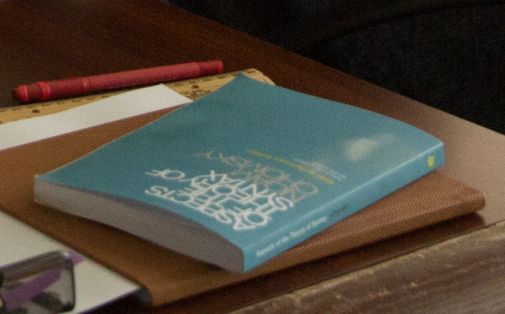
And there's even a framed photo of Chomsky on the bookshelf.
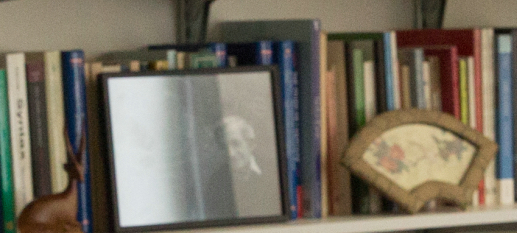
Flanking the Chomsky photo are some syntax books, appropriately enough, from Andrew Carnie's Syntax on the left to David Adger's Core Syntax on the right. (As it happens, Adger went to an advance screening of Arrival — see his writeup, "How Alien Can Language Be?") On other shelves, you might be able to spot Roman Jakobson's On Language, Ken Hale: A Life in Language, Juan Uriagereka's Rhyme and Reason, and Jessica Coon's own Aspects of Split Ergativity.
But Travis told me that the set designers were less interested in titles than colors: they were particularly interested in borrowing blue and beige books. Fortunately, she had plenty of both. Many of the blue ones are in the Linguistik Aktuell series from John Benjamins (Travis serves on the advisory editorial board). And she had lots of beige-colored journals (e.g., Language, Natural Language and Linguistic Theory, Linguistic Inquiry, Oceanic Linguistics) and conference proceedings (e.g., NELS, short for the North East Linguistic Society).
But what about the rest of the office? Many items are directly based on what the set crew saw in the McGill offices. For instance, there's a ruler on the desk near the copy of Aspects, not necessarily a common accoutrement in a linguist's office these days. But Travis says they probably got the idea from a ruler on her desk, which she uses to tear paper. Even the pencil holder appears to be modeled on one that Travis has. (Travis also has a photo of Chomsky in her office, though not the one they used.)
Here's a desk shot from the trailer:
There's that ruler again. Also, sticking out from the folder is a printout with the JSTOR logo visible. Coon thinks that came from her office, as they borrowed some of her papers: "I recognize it because I colored in the logo at some point, doodling… I'm pretty sure it was Aissen 1992." Now her doodling will be seen by millions.
Then there's the computer, as seen in the publicity still:
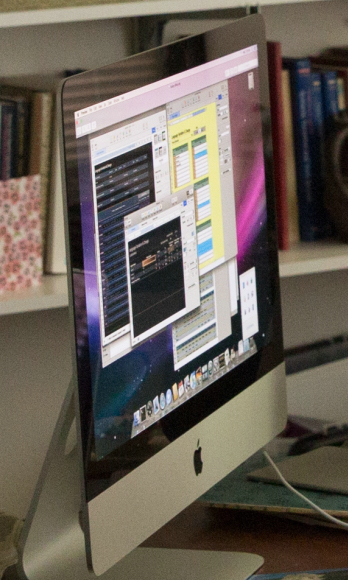
What software is running on that Mac? Sonderegger says:
I wonder if this is custom fake software/screenshots they made. I remember them talking about this at the studio and perhaps showing me/us some examples.
The upper right-hand panel has a similar color scheme to Praat, but it doesn't look like an actual Praat screen. (I did a bunch of Praat demonstrating, so it'd make sense that they would use something about it.)
The other software that was used (at their request) was Baudline, but I can't tell if any of this looks like Baudline.
It's hard to say much definitively at this resolution.
One might nitpick about certain peculiarities — Travis says, "No one her age would have printed versions of so many things. No one would put a desk so close to the file cabinets (they can't be openable)." But for the most part the set designers did a remarkable job in their recreation. "The attention to detail is just striking (if you work in McGill Ling)," Sonderegger writes. "The filing cabinets, shelves, and even the trashcan are very similar to models in faculty offices."
Update: From the comments below… McGill Alumni Magazine has a nice piece about Jessica Coon's work on the film as a linguistic consultant. And Eric Heisserer, the screenwriter and co-producer of Arrival, chimes in to tell us that despite all the Chomskyana in Dr. Banks's office, Dan Everett is her favorite!
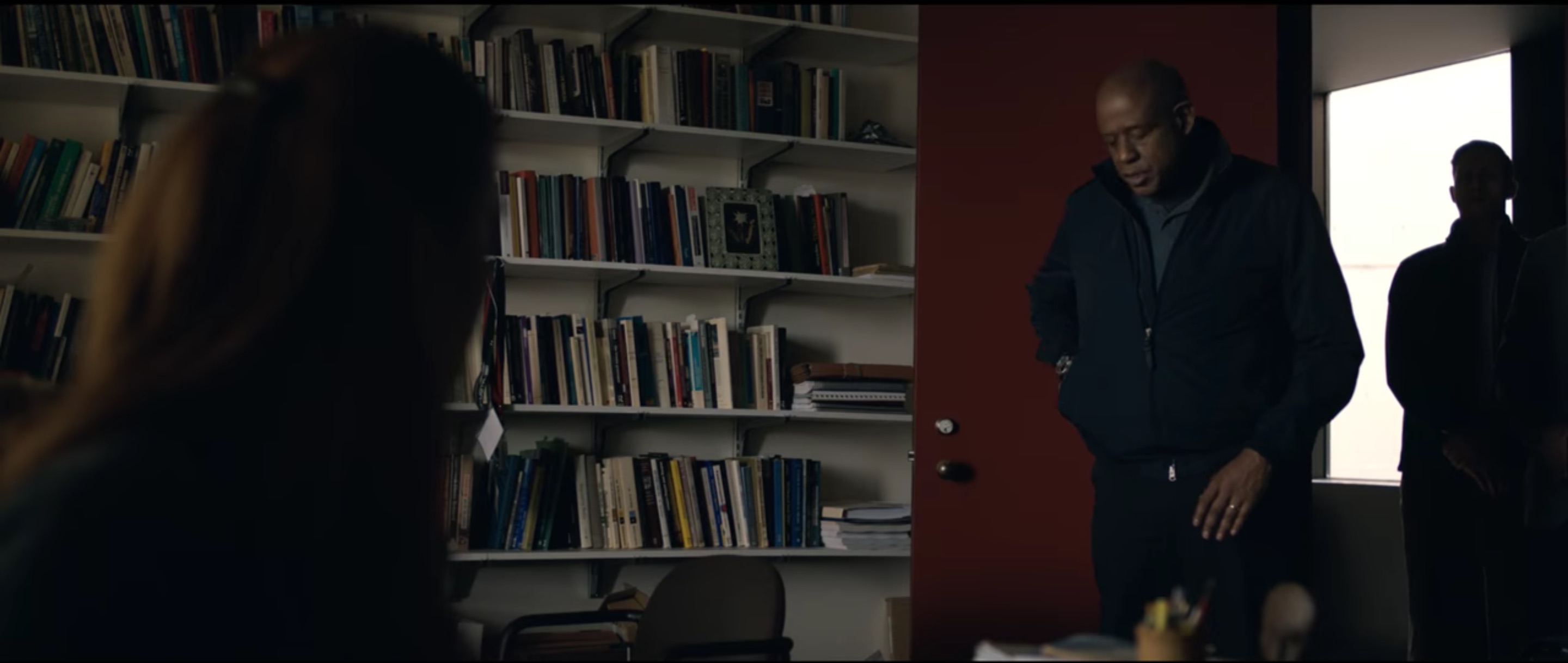
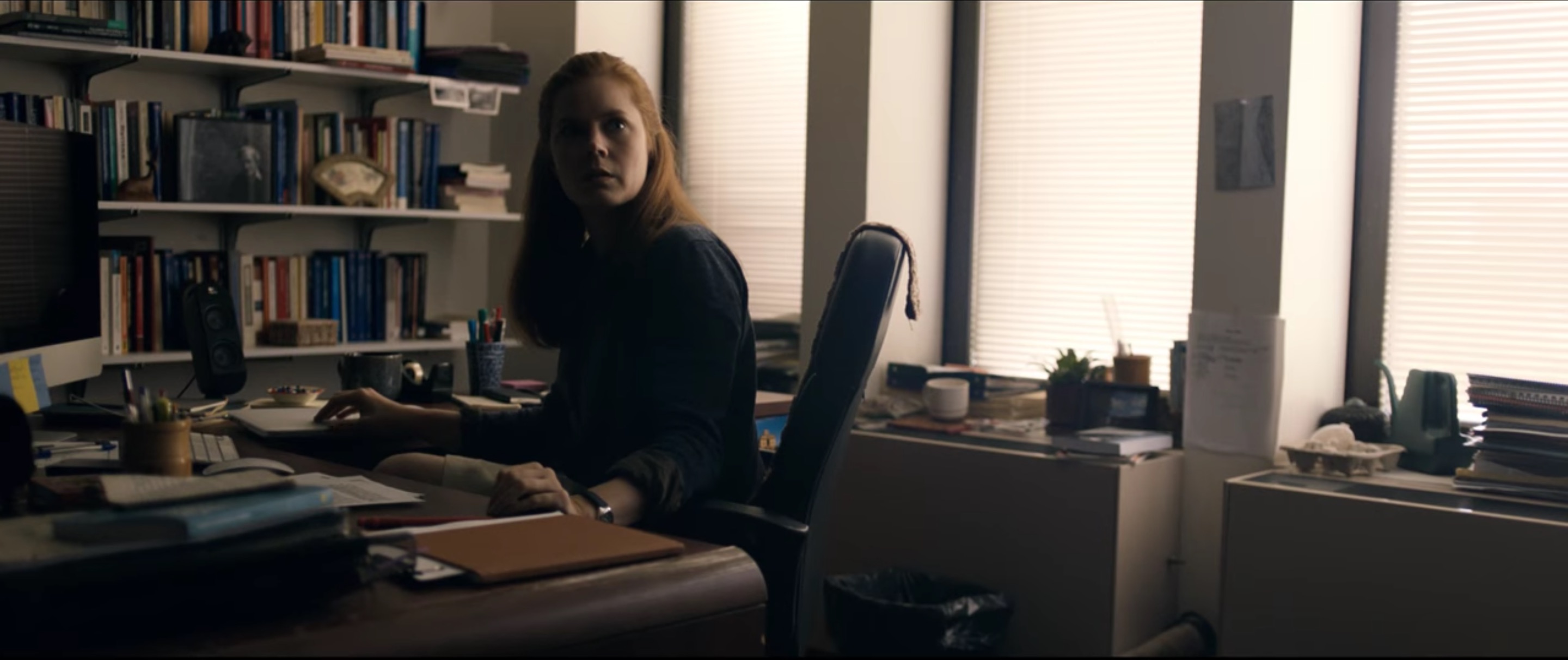
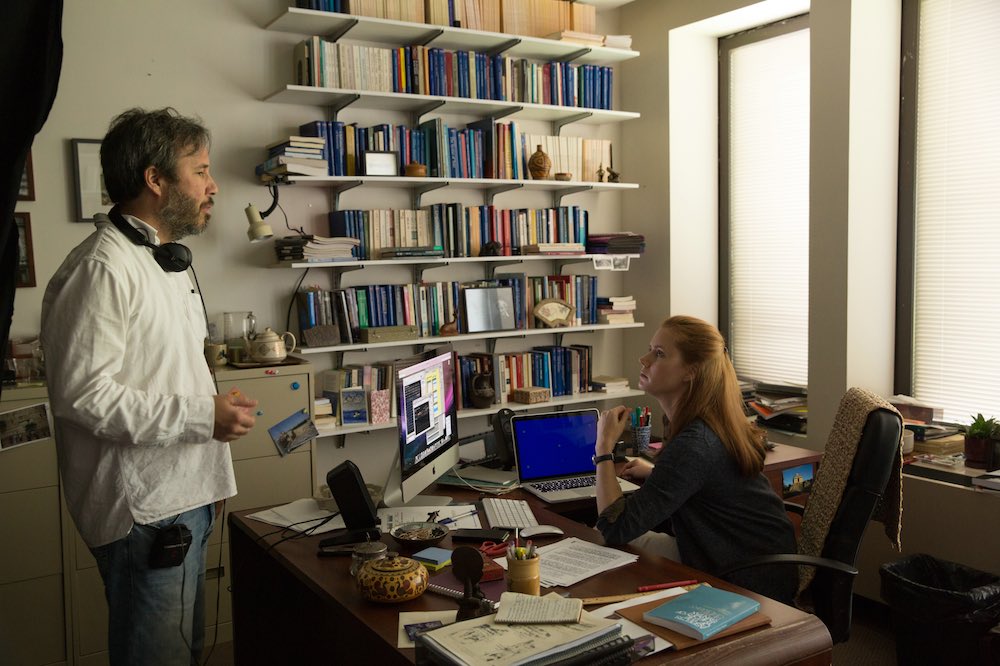
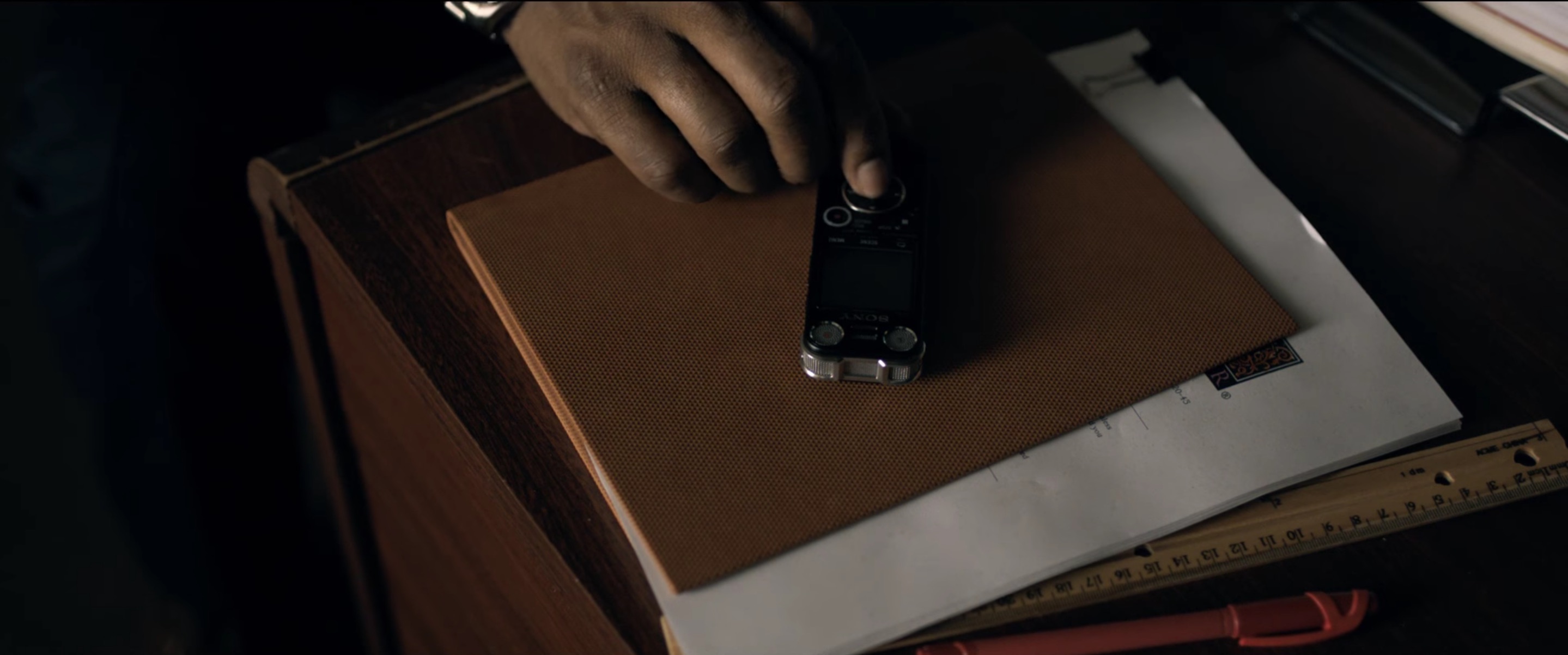
Devin said,
October 21, 2016 @ 4:42 pm
Unfortunately, the computer screenshot is a little disappointing. When you enlarge it and remove the distortion, you see it's all just pointlessly colorful spreadsheets in created in Numbers.
What's worse, the whole thing is a screenshot being viewed in Preview. You can see the Preview toolbar across the top of the screen. They didn't even bother to make if full screen.
Chris C. said,
October 21, 2016 @ 4:52 pm
Based on the headline, before I read the post, I was afraid the filmmakers did to a linguist's office what CSI-type programs do to forensic labs.
Clara said,
October 21, 2016 @ 5:07 pm
Speaking as someone who is roughly her age, I dispute the claim that no one her age would have printed versions of so many things. Also,it seems that Adams is more syntaxy than phoneticsy (at least in this write-up of her office), and in my experience (broadly generalizing here), S-side linguists are more likely to use paper than P-side linguists.
Mara K said,
October 21, 2016 @ 5:14 pm
She likes Chomsky so much she has a framed picture of him? Not what I'd expect from someone working on nonhuman communication.
JPL said,
October 21, 2016 @ 5:53 pm
Based just on the information about the film in the post here, it would seem that what would be wanted in that situation is not a Chomskyan, but someone with a knowledge of Kenneth Pike's "monolingual" techniques of elicitation and analysis in a field methods situation.
Mike Aubrey said,
October 21, 2016 @ 5:55 pm
"No one her age would have printed versions of so many things."
I do. I probably have more.
Rubrick said,
October 21, 2016 @ 6:06 pm
The Mac screen display is almost certainly fake. It's from a quite old version of OSX (telltale signs are the 3D Dock shelf and the iTunes icon) — older, I think, than could be running on her recent-vintage iMac.
Mark said,
October 21, 2016 @ 8:10 pm
Whatever the complaints, I think it is so neat that they tried to reproduce the true look a linguist's office. It would be satisfying to see some other scientists' offices well reproduced. If anyone is interested, they can start with an atmospheric scientist's office. Then maybe a materials scientist's.
Bloix said,
October 21, 2016 @ 8:25 pm
Ooh, I LOVE Amy Adams. I never ever ever go to space invader movies but Amy Adams as a linguist is something I have to see.
Eric Heisserer said,
October 21, 2016 @ 11:05 pm
Sadly we are forced to use fake screens so often for legal reasons. Using software on screens in film requires permission and often securing that permission takes longer than the production window. So we had to cheat that and didn't have the time or budget to justify changing it later in post.
What these images don't show, however, are Louise's most prized books by Dan Everett. Including his earliest work on the Amazonian tribe. The ones Chomsky loathed. Our set designer hunted down a copy of that for her.
– the screeenwriter / producer
Jason Eisner said,
October 22, 2016 @ 12:44 am
My favorite linguist-in-her-natural-habitat on film is Winnie, in Ross McElwee's gonzo documentary Sherman's March (1985). Her "office" is rather different. If I remember, she's living by herself on a lush green island off the coast of Georgia, working on her dissertation. Ross films her with fascination as she milks cows and punches down dough while earnestly explaining such topics as relativized minimality. (When I saw it in the 1990's, I was a grad student studying these very topics, and it was surreal for me to hear these phrases cropping up in the middle of a movie.)
Simon said,
October 22, 2016 @ 3:44 am
An article about Jessica Coon "A Translator for ET"
http://mcgillnews.mcgill.ca/s/1762/news/interior.aspx?sid=1762&gid=2&pgid=1344&utm_source=1132&utm_medium=email&utm_campaign=MNEWS
with great semagrams designed by Martine Bertrand.
Mara K said,
October 22, 2016 @ 10:12 am
The semagrams do look cool, but they don't fit the expectation I got from the short story that they would look like Chinese characters with massive numbers of strokes. There's probably some important symbolic reason they're circles, but what about the different colors? Are they an attempt by Banks to identify constituents?
Thorin said,
October 22, 2016 @ 10:36 am
I'm happy to see that this trailer now contains proper Arabic, with "live broadcast" in the upper left and "breaking news" in the bottom right.
Dradis said,
October 22, 2016 @ 11:44 am
Thanks for keeping us updated! I know a lot of us linguists are looking forward to this movie since it brings together two of our favorite things — sci-fi and linguistics.
Acknowledging that Louise is a fictional character… my impression is that Louise's most prized books and papers would have to be those by the fieldworker, polyglot, and teacher, Ken Hale (no disrespect to Dan Everett's work).
Simon said,
October 22, 2016 @ 1:33 pm
A very interesting image of the semagrams has been posted on twitter today :
http://img15.hostingpics.net/pics/502283logograms.jpg
They contain (Louise Banks ?) annotations to identify the different parts, and translations for most of them
Lane said,
October 22, 2016 @ 2:38 pm
Will the movie reveal the answer we really all want to know? What *will* a Martian scientist think of human languages?
Martha said,
October 22, 2016 @ 5:10 pm
I don't know how old the character is, but I'm a few years younger than Amy Adams herself, and count me as another young person who prints stuff out.
Ian said,
October 22, 2016 @ 6:23 pm
It's interesting to know that Canadians also say "tea kettle", though I can only see a teapot in the pictures.
J.W. Brewer said,
October 22, 2016 @ 7:25 pm
Off-topic except for Chomskyana (and a datapoint for that ever-expanding list of "Chomsky as the One Linguist With Name Recognition and Celebrity Status Amongst the Non-Linguist Masses"): I was driving this afternoon and heard on the car radio (admittedly on a hemi-demi-semi-"alternative" station) a newish (released earlier this year) song which mentions Prof. Chomsky in the title and chorus. The lyrics as a whole drop the names of lots of other celebrities ranging from Little RIchard to Rocky Marciano, so how Chomsky fits in is perhaps an exegetical exercise left for the listener's discretion. It's got a nice groove, regardless of what one thinks of the Minimalist Program. https://www.youtube.com/watch?v=VfWvuHECmpw
Robert said,
October 23, 2016 @ 12:57 am
What is Praat? I know from Dutch that it means "talk". I assume it is language related (although the etymology of Sonderegger does not suggest someone who knows Dutch, but rather German, possibly Alemannic). Doing a little Googling relates it to one Paul Boersma, a Dutch name if ever there was one.
Mary Kuhner said,
October 23, 2016 @ 1:01 am
This reminds me of the bit in–was it _Cast Away_? They show the lab/office of a biologist, and my husband and I turned to each other in amazement and said "It's a real lab!" Not a Hollywood lab with huge amounts of empty space around a few glowing or bubbling things, but a real lab with crowded shelves and a photocopier and a potted plant. Looked very much like our old lab in Berkeley, except with better lighting. It's the first and last time I've seen this done right; I'm excited for you linguists that there'll be another!
Alon Lischinsky said,
October 23, 2016 @ 5:10 am
@Robert: Praat is a program for phonetic analysis, synthesis and manipulation, which has been often featured in this very site
Adam F said,
October 23, 2016 @ 5:54 am
@Mara K: Maybe they should have used a photo of Nim Chimpsky.
JPL said,
October 23, 2016 @ 6:44 am
Maybe I'm old- school, but her desk seems to lack a decent archaeological depth; I mean, we can see the actual desk-top surface. And why is Aspects the only book on her desk? What dimly remembered gem of wisdom was she consulting it for? Wasn't she working on something before they came to her with this problem? Wouldn't she perhaps have pulled out her old printout of Turing's "Computing machinery and intelligence" or something of that sort, intending to look at it again? Very intriguing, worth exploring!
Rodger C said,
October 23, 2016 @ 11:34 am
"Chomsky as the One Linguist With Name Recognition and Celebrity Status Amongst the Non-Linguist Masses"
In other words, the B. F. Skinner of linguistics. Ha!
R. Fenwick said,
October 23, 2016 @ 11:26 pm
I'm disturbed how excited I got at recognising books on that shelf that I own.
@JPL:
Maybe I'm old- school, but her desk seems to lack a decent archaeological depth; I mean, we can see the actual desk-top surface
Hah! I am an archaeologist and I'm pleased to see the simile in reference to desk space isn't restricted to my department. My old PhD supervisor jokingly refers to his method of filing as "stratigraphic".
Sara said,
October 27, 2016 @ 10:08 am
JPL: Based just on the information about the film in the post here, it would seem that what would be wanted in that situation is not a Chomskyan, but someone with a knowledge of Kenneth Pike's "monolingual" techniques of elicitation and analysis in a field methods situation.
Coon, one of the consultants, is an experienced field worker *and* a chomskyan, these things are not mutually exclusive at all. Data from understudied languages is very precious to generativists.
JPL said,
October 30, 2016 @ 12:56 am
Sara @ Oct. 27, 2016, 10:08 am:
Now you're getting me interested in this film! I've now looked at the trailer and read the pieces by Adger and the McGill mag linked to above. In my comment I certainly was not intending to make a dig at Chomskyan linguistics; of course those things are not mutually exclusive. The distinction I intended was more like "theoretician" vs. "field worker", and this is apparently what the screenwriter also had in mind. My focus was on the practical problem of how to learn or understand a language from square one when the hopeful interlocutors have no common language to be used as a metalanguage or source of shared translation equivalents, and this seemed to be the situation here. I also looked at Prof. Coon's McGill page, and, although I'm not familiar with her work, she could well be a linguist in the distinguished mold of Eloise Jelinek, whose work I greatly admire. So, I might call on Dan Everett to do the field work (for his "monolingual" expertise), but also include Jessica Coon to help with the analysis.